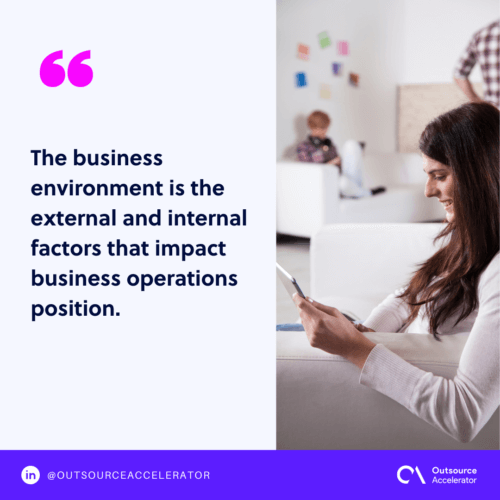Business Environment
Definition
What is a business environment?
The business environment is the external and internal factors that impact business operations position.
These factors may include employees, customer needs, supply and demand, clients, suppliers, market trends, and economic changes.
These may be found outside or inside the organization that can affect the company’s performance, profitability, and growth.
Understanding the nature of the business environment is vital; this helps to ensure that the company has the right strategy to succeed not only in the present but also in the future.

Features of a business environment
A business environment incorporates the following features:
Dynamic – Consistent changes happening socially, technologically, politically, or even economically are often the results of a dynamic business environment.
Complex – It can be quite complicated to make out how a business environment impacts companies. While it is easier to examine a particular business environment, it may be harder to determine how its changes influence other business operations.
Unpredictable – Changes in the business environment often cannot be foreseen. For example, with trends in the fashion industry, what’s in now doesn’t guarantee that it will still be on-trend in the coming months. These constant changes are uncertain.
Relative – Business environments are not all the same. In fact, its impacts will vary from one company to another or one country to another.
2 types of business environment
There are two types of business environments that you will be looking into:
1. Internal environment
The internal environment consists of factors under the company’s control. These factors help the company adapt to external business environments and achieve its goals.
The business environment factors present within a business organization define the company’s characteristics. These include the work culture and management.
Value system
The value system is a business function that judges the worth of the organization and how its work culture will be managed. It mainly consists of management practices, organizational norms, work processes, climate, and corporate culture.
Business path
To establish a good business path, you should have a mission and vision. Mission and vision allow you to see the future of the business.
These two factors clarify the changes needed to execute the business framework.
Organizational structure
The organizational structure contains the business’s hierarchical structure. This factor allows you to easily identify the roles of each employee and management.
Business culture
Every business leader has their own way of handling the business, and this results in a unique business culture.
Business cultures may be undefinable in exact terms, but this includes the treatment of employees, handling of resources, and proper dealing with clients.
Human resources
Human resources (HR) plays an important role in defining the business environment.
With the continuous growth of the business, the management of employees is minimally managed by human resources.
Equipment
Business competition is evolving endlessly; to be able to exceed your competitors, your company must possess better and more advanced equipment.
Pieces of equipment consist of physical resources.
External environment
Business is socio-economic, and several aspects of society play a role in business success or failure. The external environment represents the various factors outside the company’s control.
The external factors influencing a business environment are varied into two types: macro environment and micro environment.

Microenvironment
Microenvironment consists of factors that affect business operations and performance, such as:
- Customers – These are the target consumers of a business, both existing and prospective customers.
- Competitors – They are other businesses that offer similar products and services to the same target customers.
- Suppliers – It involves all components that provide organizations with needed resources for their daily operations.
- Media – It comprises outlets or channels businesses utilize to market their offerings to their target customers.
- Partners – These external entities that work with a particular business to meet the customers’ needs, which also affects how a business operates. Examples of partners include advertising agencies and business consultants.
- General public – It refers to any type of consumer who may have a potential interest in a brand and what it offers or that impacts how it serves the actual customers.
- Intermediaries – These are composed of everyone involved in delivering the final products to the people and in providing exceptional customer service.
Macro environment
A macro-environment comes from varied environmental influences from remote factors. The common term given to this type of business environment is PESTLE
PESTLE stands for the Political, Economic, Social, Technological, Legal, And Environmental factors of the business.
An external business environment, particularly a macro-environment, consists of the following components:
Political factors
Many countries have laws regarding establishing a business; others restrict businesses. The state of local politics highly affects the business condition. These factors involve political and legal influences.
Further, the political and legal environment has the following – government policies, labor laws, tax policies, including trade restrictions that can affect business functions or the industry itself.
Economic factors
Whether large or small companies, a country’s economic environment affects businesses. However, the open market has been highly helpful in every business. Economic factors consist of exchange rate, economic growth, and interest and inflation rates.
Since the global economy is unstable, businesses must be careful of their actions at all times.
Social factors
In today’s era, society easily grasps the attention of any business. Every society has its unique tastes and choices. This factor affects businesses worldwide.
Society brings out new trends that can lead to a rise in demand for a certain product or service.
As for social factors, it compromises the demographic factors of a country, like population growth rate, career attitudes, age distribution, and health consciousness.

Technological factors
Technology is one of the fastest evolving and innovating things in the world. Businesses that are unable to catch up to the current technological developments are having a hard time establishing their brand.
Businesses that use the latest technology to their advantage are now way ahead of their competitors. Information technology has now become a leading business due to its huge demand.
Examples of technological factors are technological awareness, automation, and research and development.
Legal factors
Rules, laws, and regulations are primary factors that every business should consider in their external environment.
There are laws for businesses in every country across the globe, and every business has to follow these laws. Many businesses think that these laws were made to drag them down, but little did they know that regulations help their business to prosper.
Environmental factors
The world is currently facing an environmental crisis and is a factor for business development, businesses are expected to cope with these problems.
Environmental factors like the cold season bring down the agricultural business but it can boost tourism. Businesses focus on organizing a strategic way to handle these factors.
Other examples of environmental elements include natural disasters, climate, weather, and environmental policies.
How a good business environment helps your company
Business enterprises can greatly benefit from having a good business environment in the following ways.
- Improved performance. A good business environment helps teams work and engage with their peers better, which in turn improves the company’s performance.
- Gaining useful resources. Having a good environment also helps business leaders tap into useful resources in growing their firms.
- Mitigating risks. What’s more, a good business environment is crucial in identifying risks and threats a business can face. In turn, they can formulate ways to mitigate them and maintain smooth operations.







 Independent
Independent




